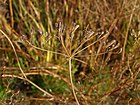Note: This is a project under development. The articles on this wiki are just being initiated and broadly incomplete. You can Help creating new pages.
Carum carvi - Asitajiraka, Caraway
Caraway is the fruit of a biennial herb. The plant has a fleshy root and slender branched stem that attains a height of 0.5 to 0.6 mtrs, with small white flowers in compound umbels.
Contents
- 1 Uses
- 2 Parts Used
- 3 Chemical Composition
- 4 Common names
- 5 Properties
- 6 Habit
- 7 Identification
- 8 List of Ayurvedic medicine in which the herb is used
- 9 Where to get the saplings
- 10 Mode of Propagation
- 11 How to plant/cultivate
- 12 Commonly seen growing in areas
- 13 Photo Gallery
- 14 References
- 15 External Links
Uses
Kill hookworms, Gastric problem, Flatulence, Bowel spasms, Mild diabetes, Cough, Atherosclerosis, Lower blood pressure, Cholesterol, Menstrual cramps.
Parts Used
Chemical Composition
Caraway fruits may contain 3% to 7% essential oil. The aroma of the oil is mostly dominated by carvone (50 to 85%) and limonene (20 to 30%); the other components carveol, dihydrocarveol, α- and β-pinene, sabinene and perillyl alcohol are of much minor importance.[1]
Common names
| Language | Common name |
|---|---|
| Kannada | Jeerige, Jiaka |
| Hindi | Jangi dhania, Jeerka |
| Malayalam | NA |
| Tamil | Appakacaccompucceti, Appakacam |
| Telugu | Seema jeeraka, Seemai sompu |
| Marathi | NA |
| Gujarathi | NA |
| Punjabi | NA |
| Kashmiri | NA |
| Sanskrit | Asitajiraka, Bahugandha, Bhedanika |
| English | Caraway, Caraway seed, Kummel |
Properties
Reference: Dravya - Substance, Rasa - Taste, Guna - Qualities, Veerya - Potency, Vipaka - Post-digesion effect, Karma - Pharmacological activity, Prabhava - Therepeutics.
Dravya
Rasa
Guna
Veerya
Vipaka
Karma
Prabhava
Habit
Identification
Leaf
| Kind | Shape | Feature |
|---|---|---|
| Alternate | Stalked | Basal leaf-stalk channelled, stem leaf-stalk sheath-like, base with stipule-like lobes. Basal leaf blade long, 2–3 times pinnatel |
Flower
| Type | Size | Color and composition | Stamen | More information |
|---|---|---|---|---|
| Unisexual | 3–5 mm | White | Stalks on secondary umbels and flowers very different lengths and Flowering time is June–August |
Fruit
| Type | Size | Mass | Appearance | Seeds | More information |
|---|---|---|---|---|---|
| Broadly elliptic | Flattish | Single | Narrowly ridged, dark brown, 3–6 mm (0.12–0.24 in.) long schizocarp, highly fragrant when broken |
Other features
List of Ayurvedic medicine in which the herb is used
Where to get the saplings
Mode of Propagation
How to plant/cultivate
Succeeds in ordinary garden soil as long as it is not too wet in winter. Prefers a moist soil in full sun or partial shade. Tolerates a pH in the range 4.8 to 7.6. Caraway is a well-known herb that has been cultivated for its culinary and medicinal uses since ancient times[3]
Commonly seen growing in areas
Hills of South India, Plains of North India, Hills.
Photo Gallery
References
External Links
- Ayurvedic Herbs known to be helpful to treat Kill hookworms
- Ayurvedic Herbs known to be helpful to treat Gastric problem
- Ayurvedic Herbs known to be helpful to treat Flatulence
- Ayurvedic Herbs known to be helpful to treat Bowel spasms
- Ayurvedic Herbs known to be helpful to treat Mild diabetes
- Ayurvedic Herbs known to be helpful to treat Cough
- Ayurvedic Herbs known to be helpful to treat Atherosclerosis
- Ayurvedic Herbs known to be helpful to treat Lower blood pressure
- Ayurvedic Herbs known to be helpful to treat Cholesterol
- Ayurvedic Herbs known to be helpful to treat Menstrual cramps
- Herbs with Leaves used in medicine
- Herbs with Fruits used in medicine
- Herbs with Seeds used in medicine
- Herbs with common name in Kannada
- Herbs with common name in Hindi
- Herbs with common name in Malayalam
- Herbs with common name in Tamil
- Herbs with common name in Telugu
- Herbs with common name in Sanskrit
- Herbs with common name in English
- Habit - Herb
- Index of Plants which can be propagated by Seeds
- Herbs that are commonly seen in the region of Hills of South India
- Herbs that are commonly seen in the region of Plains of North India
- Herbs that are commonly seen in the region of Hills
- Herbs
- Apiaceae










